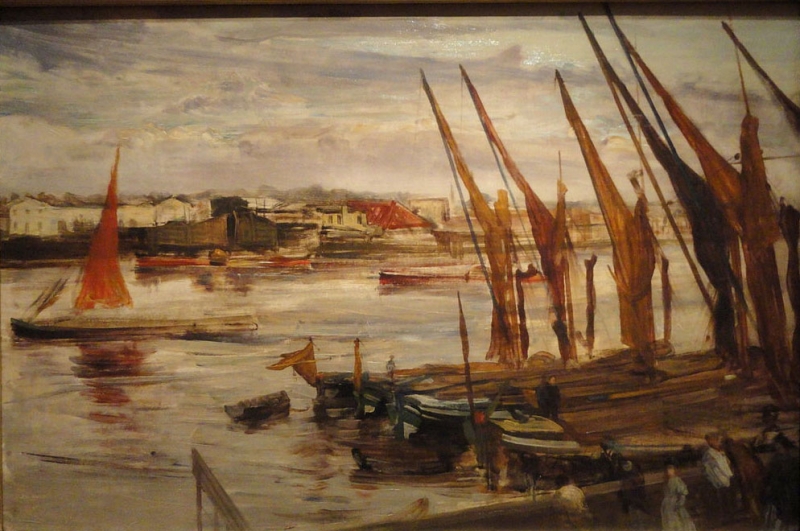Home > Catalogue > Browse > Battersea Reach << >>
Provenance
- 1860s: sold by Whistler to George John Cavafy (1805-1891), London, £30.0.0;
- 1892: sold by his son, John Cavafy (1839-1901), to Edward Guthrie Kennedy (1849-1932) of Wunderlich, New York dealers, in July 1892, who paid £650 for it and three other paintings by Whistler;
- 1893: bought from Kennedy by Isaac Cook, jr (1867-1926), Jr, Maine.
- 1918: bought from John Levy, New York dealer, by James Parmelee (1855-1931), 30 December 1918, for $15,000;
- 1931: passed to his widow, Alice, Mrs J. Parmelee (1863-1940);
- 1940: bequeathed to the Corcoran Gallery of Art (acq. no. 41.30);
- 2015: transferred from the Corcoran Gallery of Art to the National Gallery of Art, Washington, DC.
Whistler claimed that he had originally sold 'Battersea' to George John Cavafy (1805-1891), London, for £30.0.0. It was, he said, 'a charming Whistler - wants cleaning, varnishing, & glazing - and then you will see as to price. I should think £400 or £500 But I must really see it again.' 1
G. J. Cavafy and his son John Cavafy (1839-1901) were prepared to sell several paintings in 1892. There was some devious manipulation of the market, during which pictures were offered to an American collector, John Chandler Bancroft (1835-1901), and then sold to the New York art dealer E. G. Kennedy. The dealer paid £650 for Battersea Reach and three other paintings, namely The Last of Old Westminster [YMSM 039], Variations in Flesh Colour and Green: The Balcony [YMSM 056], and Harmony in Blue and Silver: Trouville [YMSM 064] 2 Whistler's view of the sales was a mixture of pleasure at the prices and disgust at his patrons' greed. He told his sister-in-law:
'I had lately waited until with the beautiful pictures before us, I could tell you that John who in his rabid greed for money sold even the present I made him has been beaten completely! - for in his indecent haste he has parted with the works for only a quarter of what they will at once fetch! - So that he might have had about twenty two or twenty three times what they ever gave me for them! - That is counting in of course my present!. -
You will say that he got £650 - after all - that is more than seven times what I got - as well as I remember - Yes but to have disgraced himself - (for I shall tell the story of the sale of the present everywhere, now that the pictures are safe! -) - and from a criminal point of view, for so little!!
... The idea of Johns peddling these beautiful things away! Why they were possessions! - They are all going to America except my Courbet.' 3
By October the painting was hanging in Kennedy's house in New York. 4 Although Kennedy was concerned at the treatment of Bancroft and offered to let him have the remaining pictures, Whistler's lawyers said that Bancroft had no legitimate claim. 5
Battersea Reach was sold, with the assistance of Whistler, to Isaac Cook, jr (1867-1926), Jr, Maine, in 1893. 6 On 17 August 1893 Whistler wrote a certificate of authentication for its new owner:
'The picture called "Battersea Reach", was painted by me, I cannot remember exactly in what year, but when I was living in Lindsey Row, Chelsea -
It was a view of the opposite bank of the river, from out of my window, in Lind - on a brilliant autumn evening - and the painting is a favorite of mine -
It was bought from me by Mr. Cavafy - and remained always in the family until sold by Dr. John Cavafy to Mr. E. G. Kennedy of New York.' 7
It is not clear if there is a gap in the provenance of a few years before it was bought from the New York art dealer, John Levy, by James Parmelee (1855-1931) for $15,000 on 30 December 1918. On his death in 1931, the painting passed to his widow, who bequeathed it to the Corcoran Gallery of Art in 1941. The recent closure of the Corcoran Gallery has resulted in the transfer of its collection to the National Gallery of Art in Washington, DC.
Exhibitions
It was not exhibited in Whistler's lifetime, as far as is known. Whistler wanted to include it in the World's Columbian Exposition, Department of Fine Arts, Chicago, 1893. 8 Indeed it was noted as 'promised' by E. G. Kennedy, but it does not seem to have been shown there. 9
Notes:
1: Whistler to E. G. Kennedy, 10 June 1892, GUW #09680.
2: Whistler to J. Cavafy, [8 June 1892], GUW #00565; Whistler to Kennedy, 10 June 1892, GUW #09680. See also GUW #06172, #09841, #07210, #09828, #09704, and #11556.
3: Whistler to H. E. Whistler, [7 August 1892], GUW #06718.
4: Kennedy to Whistler, 26 October 1892, GUW #07203.
5: 2 December 1892, GUW #07207. See Sieger, William B., 'Whistler and John Chandler Bancroft', Burlington Magazine, vol. 136, no. 1099, October 1994, pp. 675-82, Jstor Online.
6: Cook to J. Pennell, 13 September 1911, LC PC; Secretary of the City Art Museum, St Louis, to J. Pennell, 16 September 1911, LC PC.
8: B. Whistler to E. G. Kennedy, [22 October / November 1892], GUW #09703.
9: Whistler to E. A. Abbey, [November 1892 / 10 January 1893], GUW #03181.
Last updated: 1st December 2020 by Margaret





